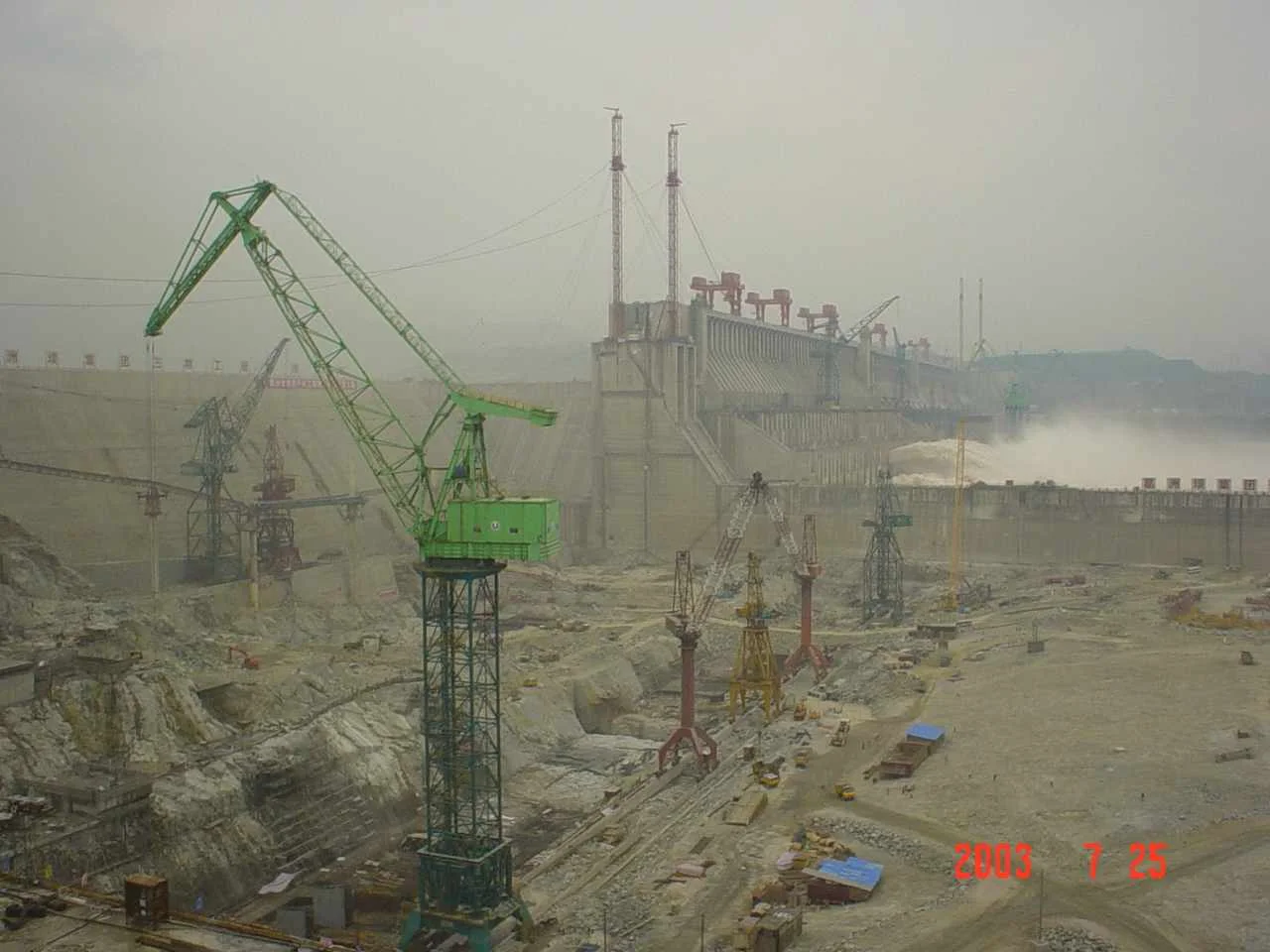Decades of sorrow, but operations still continue at the Three Gate Gorge
April 29 2005
NATURE can be brutal, but the attempts to tame it can create an ocean of new problems.
At Sanmenxia, or the 'Three Gate Gorge,' situated in central China's Henan Province, the urge to control and conquer the fearsome Yellow River has led to decades of controversy, and to a heated national debate about the costs and benefits of trying to engineer away your problems through the construction of massive hydropower projects.
The Three Gate Gorge has been blamed for the drying up of the famous Yellow River and for inundating nearby cities, including the ancient capital of Xi’an. Now, as experts call for its closure after more than four decades of floods and failures, plans are still being drawn up to improve its operations.
Wandering across the dam’s crest, local officials draw our attention to the width of the walkway. Had the original planned height of the dam been maintained, it would have tapered slightly to leave a much narrower overpass. But throughout its fraught operating history, the project’s design has constantly been revised in order to cope with the brute contingencies of nature and a host of unforeseen consequences.
"The Sanmenxia project has been renovated several times," said Liu Hongbin, vice chief of the Sanmenxia Yellow River Hub Management Bureau. "The first time was in 1967 and was completed in 1969, while the second renovation commenced in 1969 due to the unsatisfactory nature of the first renovation."
The dam has been described as a "complete mistake" by Zhang Guangdou, a water resources expert involved in initial construction. It has also been blamed for tributary floods and for cutting the Yellow River’s downstream water flow so dramatically that it could no longer even reach the coast..
The reason why the Yellow River is so named is because of the massive volume of silt that has, for centuries, been swept into the river from the sandy, denuded banks and loess plains of western China.
As Judith Shapiro explains in her seminal Mao’s War Against Nature (2001), Hydropower engineer Huang Wanli knew from the beginning that the project would be a disaster and that the silt in the river would prove too much for the turbines. For his troubles, Huang was purged and silenced.
At the site, Liu was frank about the project’s flaws. "They didn't think enough about the silt problem during the process of construction," he admitted.
But it was worse than that. Though experts issued warnings about the silt, engineers decided to block up the sluice gates in order to leave the Yellow River’s lower reaches clean and fulfill a mad folk prophecy that claimed that the waters would run clear as soon as a Great Leader emerged. Huang said the plan “distorted the laws of nature”.
"The design just didn't suit the conditions of the Yellow River," Liu told Running Dog.
The flaws were obvious. By 1962, when the project began producing electricity, serious silt build-ups were already causing problems. Emergency reconstruction on the project was required, and the Soviet-designed generating units had to be removed and replaced.
"It wasn't a problem with the generating units," Liu noted, "but a problem with the reservoir design."
By 1967, as the sedimentation continued to accumulate, and at considerable financial cost, the sluice gates were finally opened up. It was too little too late, however. In 1969, Xi'an, lying on one of the Yellow River's nearby tributaries, was flooded.
Following that disaster, the project developers chose to decommission the dam and start again. Water expert Zhang told China Central Television last year that reconstruction failed to solve the problems in any fundamental way, despite a significant reduction in planned output capacity and in the height of the dam.
There are currently seven power generating units in operation, with a designed capacity of 410 megawatts, delivering an average of 1 billion kilowatt-hours a year to the local power grid. The capacity and volume is much lower than originally designed, Liu Hongbin explained. The initial plans allowed for a total capacity of 1.16 gigawatts.
Last year, fifteen officials from the Hua County in Shaanxi Province joined in the calls for the suspension of the Sanmenxia project. The county regards itself as one of the primary victims of the dam, experiencing serious floods as a result of the sedimentation that has accumulated on the Yellow River tributary, the Wei River. As long as the hydropower plant continues to function, the water level in the reservoir needs to remain high. That means more silt, higher riverbed levels and a greater chance of flooding.
"We can say that since the feasibility studies for the construction of the project began, there were disputes," Liu Hongbin said. "Proposals included reducing the size of the dam. The main opponents were in Shaanxi and Xi'an [Shaanxi's capital city], along the Wei River."
"Experts mainly focus on the impact of sedimentation," Liu continued.
"In terms of the technology, experts are concerned about how much impact the reservoir's operation will bring to the upstream reaches of the Yellow River. But in terms of administration, the main issue lies with the distribution of benefits, since the main province being flooded is Shaanxi, while the main beneficiaries [of flood control] are Henan and Shandong."
"In 2003, the Wei River encountered a long rain season during the autumn," he explained. "The downstream suffered badly, and under these circumstances, experts again raised the question of whether to demolish the dam or keep it."
"Some suggested that setting aside the flood-preventing role, the hydropower generation of the project, with an installed capacity of 410,000 kW, accounts for only a tiny part of the Henan power grid, and is not really worthwhile to maintain."
However, demolishing the dam would not be the panacea that some people regard it to be, he said.
"Other experts have suggested that the project be demolished and all the area be restored to its original appearance. However this is impossible, since the nature of the river has been changed and it is impossible to get back to the previous appearance."
He also sought to stress the downstream flood control functions of the dam, rather than its impact on the upstream tributaries.
"If the Sanmenxia dam was demolished, the flood prevention capacity [in the region] would be greatly reduced since the flood prevention capacity of Xiaolangdi [a dam further downstream] stands at only 4 billion cu m," he stressed, "while that of Sanmenxia stands at 5.5 billion to 6 billion cu m."
The thankless tasks of running and improving the controversial project continue.
"We started an experiment on the operation of Sanmenxia water reservoir in 2002," he said. "We planned to watch for the sedimentation effects caused by reducing the water level of the reservoir from 320 m to 318 m. The results show that the current mode of operation at Sanmenxia is not the main cause of the large amount of sedimentation filling up the reservoir. The problem is mainly caused by the volume of the incoming water and cannot be solved by adjusting the water level of the reservoir."
"We currently drain the mud and sand during the flood season (when the incoming water flow stands at above 2,000 cu m per second), and generate power during the drought season (when the coming water volume stands at lower than 1,500 cu m per second, and normally at 600 or 700 cu m per second)."
Liu and other local officials expressed their frustrations about the negative media portrayal of the Sanmenxia dam. "They never report the years of effective flood control," one said, "but only the occasions when floods do take place."
And so, the Sanmenxia Dam has been demolished, rebuilt, and subjected to renovations and experimental solutions that themselves lead to new sets of problems further down the line. Senior officials of other flagship hydropower projects, such as Lu Youmei, the former head of the Three Gorges Project Corporation, have cited Sanmenxia as a cautionary tale for developers across the country.
Huang Wanli said the damming of such a large-scale waterway as the Yellow River was always a monumental error, and he believed the mistake has been repeated on the Yangtze. Time will tell whether China's hydropower developers have learnt from the mistakes at the Three Gate Gorge.



